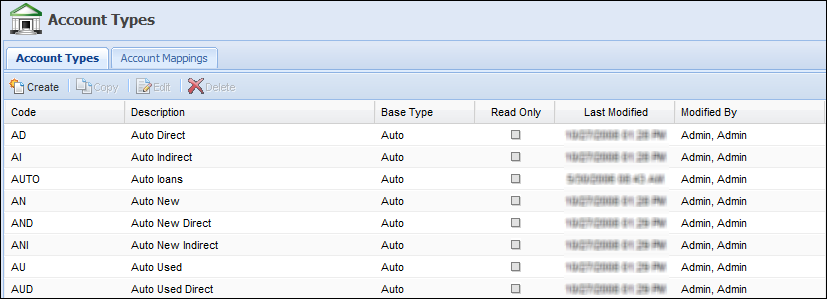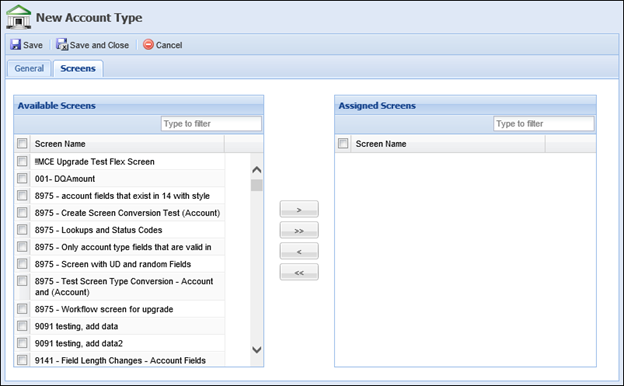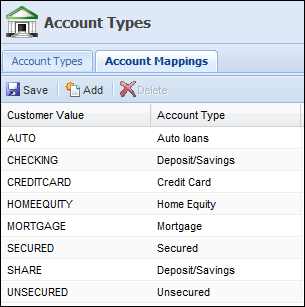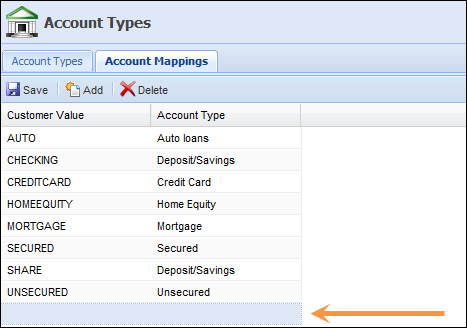Account Types may vary from institution to institution. The Akcelerant Framework allows for the creation of account types to suit business needs while supporting standard account types for interface usage. Account types are a way to group/categorize specific accounts to allow for easier reporting, queuing, etc. within the Framework.
 |
Account Types with the Read Only box checked can be copied but not edited. These are standard Account Types. These standard Account Types are Credit Card, Deposit, Misc and Mortgage. |
For example, an institution may have ten different types of auto accounts. They can map those ten different codes to the Auto account type and then use the account type field to select auto.
Account Types
The Account Types page displays a list of current Account Types populated in the Framework.
 |
Account Types included in a batch import file are not automatically added to this list, they have to be manually added. If a new product and code is added to the core system, it is required that the new value is added to Account Types Mappings. If a code gets imported into the Framework and there is no account type mapping for it, it is set to Miscellaneous and the exact account type is not known. |
Navigate to the System Mangament > Accout Types page. From this page administrators can create, copy, edit and delete account types.

The following columns display in the Account Types tab:
| Column Name | Description |
| Code | Displays the code associated to the account type. This code needs to match account types being imported from the core. |
| Description | The actual name of the account type. |
| Base Type | Displays what the account type is based on. |
| Read Only | If checked green, the account type cannot be edited. |
| Last Modified | Denotes when the account type was last modified. |
| Modified By | Denotes who made the last modification on the account type. |
Account Type Attributes
All Account types share common attributes that are defined while creating coyping, or editing an account type.
General

General attributes are located within the General Tab:
| Field | Description |
| Code | Enter the code of the new account type. This is a required field. |
| Description | Enter the description of the new account type. This is a required field. |
| Base Type | Select a base type from the base type from the drop-down list. Base types are system defined. |
Screens

Screen attributes are located within the Screens Tab:
| Field | Description | ||
| Assign Screens |
Select the check box next to the screen name and use the arrows to move it from the Available list to the Assigned Screens list. Screens in the Assigned list are available from the Screens menu in the left navigation panel of the workspace.
The order of the screens listed in the workspace screen menu can be rearranged by dragging and dropping screens in the Assigned list. This is not a required action. |
 |
If authoring Business Rules, it is recommended to select the Sync.Lookups button on the Application Toolbar in Rules Manager before authoring a new rule in order to ensure the newly created Account Type is available within the Rules Management Application. |
- Click Create on the account types page.
- The New Account Type screen appears. Navigate through the General and Security tabs to update attributes.
- When finished entering all attributes, click Save and Close to save the Account Type and return to the Accout Types Page. The new account type is displayed in the Account Types grid.
- Click Cancel to return to the Account Types page without saving.
 Copying an Existing Account Type
Copying an Existing Account Type
- Select to highlight the Account Type being copied and click Copy.
- The Account Type detail screen appears with values copied from the selected account type.
- Make any necessary changes to the Account Type in the General and Screens tabs.
If copying an existing account type, the Account Type Code on the General tab must be changed since it cannot match an existing Account Type code in the Framework. Otherwise an error occurs.
- When finished making changes, click Save or Save and Close to save the Account Type and return to the Account Types page.
- Click Cancel to return to the Account Types page without saving.
 Editing an Existing Account Type
Editing an Existing Account Type
- Select to highlight the Account Type being edited and click Edit.
- The Edit Account Type screen appears.
- Make any necessary changes to the Account Type in the General and Screens tabs.
- When finished making changes, click Save or Save and Close to save the Account Type and return to the Account Types page.
- Click Cancel to return to the Account Types page without saving.
- Select to highlight the Account Type that is being deleted and click Delete.
- A confirmation message appears. Click Yes to delete the Account Type. Click No to return to the Account Types page without deleting.
Account Mappings Tab
The Account Mappings tab allows Administrators to Map interface codes to the appropriate account types in the Framework. From the Account Mappings page administrators can add new mappings and delete mappings. Any Customer Values not mapped are defaulted to the "Miscellaneous" account type.

The following columns display on the account mappings page:
| Column Name | Description |
| Customer Value | Displays values that are mapped to specific account types imported from the core. |
| Account Type | Account type that is mapped to the specific customer value. |
- Click Add on the account mappings page.
- A new row appears in the grid.
- Within the new row, click in the Customer Value column to type in the new customer value.
- Within the new row, click in the Account Type column to display an Account Type drop-down. Select the desired account type from the drop-down.
- Click Save to save the new account mapping. Click Delete while a row is highlighted to delete the account mapping.
Mapping to account types does not occur automatically when new mappings are added via this screen. The actual mapping to account types occurs during the morning batch import process.

